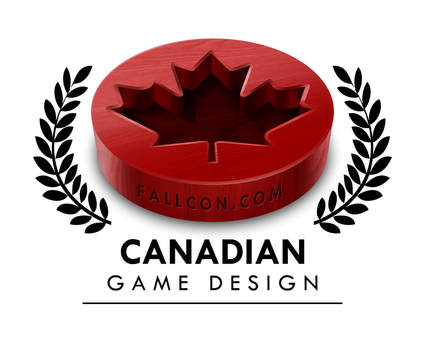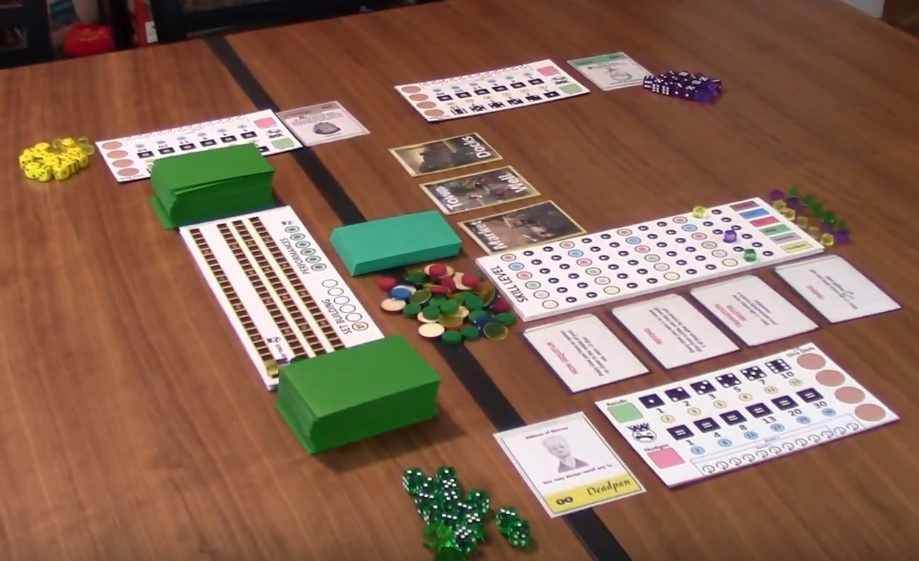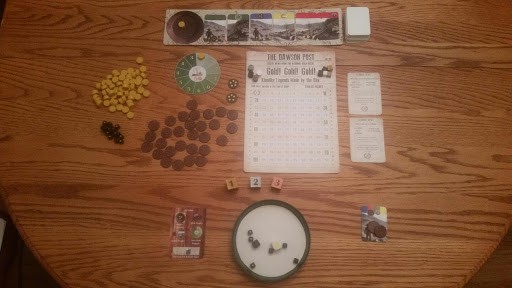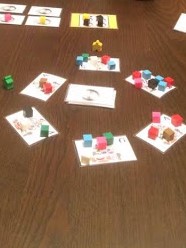FallCon 31 is less than a week away and the clock is ticking down to the reveal of the 2018 Canadian Game Design Award winner. Out of twenty submissions from designers all across Canada, the field was narrowed down to four finalists:
- Crash Factor by Herb Stanway
- Jester's Folly by Adam Wyse
- Klondike Kings by Shawn Kantymir
- Yes, Chef! by Dennis Ku and Daniel Rocchi
We are going to take a closer look at each game design. All the designs will be available to test out at FallCon.

Crash Factor is a dexterity game by Herb Stanway from Montreal, Quebec. It is a two to four player game that plays in about 20-40 minutes. The board is an eight pointed star shape, with a ring system layout in the center, balanced atop a central spherical fulcrum. The goal of the game is to be the first player to place all your weights on the board without causing the board to topple. Players take turns rolling a die and placing weights equaling the roll on the board. It's a game involving both skill and strategy to win.
Herb Stanway came up with the game idea at the Just for Laughs Comedy Festival about 5 years ago.
"They have an outdoor area where they put all kinds of games," says Herb, "All kinds of board games, arcade games and even larger games like human-sized Foosball."
There he discovered a game involving a large 4 foot diameter wooden disc balanced on a pylon and a softball. People took turns attempting to place blocks of wood on the disc without causing it to tip over. He wanted to create a smaller version of it for a party at his house and has been refining it since then. Early versions included using badminton shuttles for the balance pivot and various coins for the weights.
 Subsequent designs involved calibrating the weights and the board so some of the guesswork would change to a calculated risk for players. Bringing strategic elements into the game is something Herb is very passionate about. He states,
Subsequent designs involved calibrating the weights and the board so some of the guesswork would change to a calculated risk for players. Bringing strategic elements into the game is something Herb is very passionate about. He states,
"Dexterity is not just for young kids. This game is built to be able to play 12 and older because it has a depth of strategy to it. There aren't any dexterity games out there that combine calculated risk, strategy and tactics with skill, intuition and chance"
He may very well be right. While there are several dexterity games around, like Riff Raff, Rhino Hero and Jenga, the addition of the rings and cards help make the game more cerebral and a player must combine many different disciplines of thought and skill to be successful.
Crash Factor has also been a finalist in the Plateau d'Or 2016 and Mondial des Jeux 2017 Protolab Contest. Could it be the first dexterity game to win the CGDA? Find out at the FallCon 31 Auction, where the winner will be announced.
Jester's Folly is a set building and dice rolling game by Adam Wyse from Calgary, Alberta. It is a game for 2-6 players and plays in 30-60 minutes. The game is takes place in medieval times, with each player vying for the recently vacated position of King's Jester by showcasing their talent with stand up comedy. Players create two sets of jokes by drafting joke cards, upgrading skills, and acquiring abilities. The player with the most laughs (points) at the end of two sets is the winner.
One of the most unique things about the game is the performance phase. For matching the symbols of the audience and the transitions from the first card, players gain dice, roll them and assign them on their player board. They can then choose to score the points on their board or take dice from the next card. Knowing when to take points or keep going is critical because there are only so many spaces and rolls you have available.
 As one of Adam’s oldest designs, it’s one he has worked on sporadically for the last four years or so. It was a prior CGDA finalist in a previous iteration titled Open Mic, which was strictly focused on the stand-up comedy aspect. A publisher who looked over the game suggested that it needed a theme. It prompted the addition of the Medieval theme and also gave Adam an opportunity to make some big changes.
As one of Adam’s oldest designs, it’s one he has worked on sporadically for the last four years or so. It was a prior CGDA finalist in a previous iteration titled Open Mic, which was strictly focused on the stand-up comedy aspect. A publisher who looked over the game suggested that it needed a theme. It prompted the addition of the Medieval theme and also gave Adam an opportunity to make some big changes.
“I didn’t like how laughs were scored... taking a whole bunch of dice and rolling them... it didn’t feel like you were performing a set.” With the new mechanics, players collect and roll dice joke by joke.
Adam Wyse is no stranger to the CGDA and game designs. He has been a finalist for the CGDA five times in the last four years. He has a few published games, including 2015 CGDA finalist Masque of the Red Death (published by IDW Games), with more due out in the next couple of years. Adam won the 2017 Golden Arbitus Award for Lepre-Contractors and the 2016 Ion Award for Cypher. Will this be the year he finally takes home the CGDA? Find out on September 22.
Klondike Kings is a dice-rolling and set-collecting game by Shawn Kantymir from Ottawa, Ontario for 2-4 players that plays in about 30 minutes. Players are thrust into the Klondike Gold Rush in the late 1800s, holding pans filled with a variety of dice. Simultaneously, players shake their pans, racing to get the best roll they can, before setting the pan down and grabbing 1st, 2nd, and 3rd initiative markers. Once the last marker is grabbed, the last player still shaking has to stop immediately. In turn, players get nuggets based on the number of gold pips on their dice and paydirt tokens and may take two actions to purchase additional claims, bank gold, make a discovery or work current claims. At the end of the round, players reset their pans and a new round begins.
The end goal of the game is to have the most victory points. Points are earned by banking gold, going to the bank the most, panning the most gold in a round, sets of different tools found on claim cards and from your claims - 3-part panoramas which score points based on color match of the panorama.
 The panning is the most interesting and eye catching part of the game. It creates a level of excitement and intensity as you race against other players to get the best roll, as quickly as possible. As Shawn Kantymir told us,
The panning is the most interesting and eye catching part of the game. It creates a level of excitement and intensity as you race against other players to get the best roll, as quickly as possible. As Shawn Kantymir told us,
“Yes, the panning is gimmicky, but I think it is a good one. To be good, I think it has to make sense for the theme of the game and in this case, mimics the real life production of wealth during the gold rush.”
The game concept came from documentaries on the Klondike Gold Rush.
“This was something that I found interesting, watching television shows such as Gold Rush on the Discovery channel. I think the appeal was the thrill of discovery and the adventure of the men and women who risked everything to get rich during the Klondike gold rush.”
The idea of capturing the feeling of someone who was discovering gold from that time period was the main focus for the designer.
“Capturing that feeling as best I could was not as strong as I would have liked, and until I had something to represent that better, I felt the game was not complete.”
The claims presented a problem - trying to create something that was balanced and not restricted was one of the big challenges with the game design. The other challenge Shawn Kantymir had was to keep the production costs down, and after some work, cut the number of dice used in the game down by almost half.
That hard work has paid off for this first-time finalist in a design competition.
“I was very happy and humbled that others found my game worthy of being in the finals of this competition and provided some self-confidence about my design choices. Until you have independent judging outside your small game group sphere, you don’t truly know if your game will appeal to others as well.”
Could this be his first game design winner? We’ll find out at the FallCon Auction on Saturday.
Yes Chef! is a resource management game for 2-4 players that plays in 45-60 minutes by Dennis Ku and Daniel Rocchi from Toronto, Ontario. Players take the role of apprentice chefs in a cooking competition. Moving their pieces around a central circle of ingredients, players either take ingredients from the area or swap ingredients with other players on the same space, then place each ingredient on available stove burners in their play area. They then complete orders, possibly with side orders for bonus points, adding more burners to their playing area. Players can also move up the chef's challenge track to earn more points at the game's end by using specific ingredients in the order that the head chef prefers.
The game's most unique component is the movement of the pawns around the central area. At first, it is very much mancala style movement, but then players can trade ingredients back to move additional spaces around the board. The other unique part is the selection of ingredients. Players may only take all of one type of ingredient or one of every different ingredient at the station, but only if they have the space in their play area for it. It creates a very unique resource collection mechanic.
 The game design was inspired by Dim Sum, one of the designers' favorite restaurant type, and the way food was put on, passed around and taken off a lazy susan. They were recommended by a publisher to change lazy susan design to something else. So the lazy susan was scrapped, transitioned to the system they have now and it became a game about sailing around a lake. Designer Daniel Rocchi explains the ironic twist which followed:
The game design was inspired by Dim Sum, one of the designers' favorite restaurant type, and the way food was put on, passed around and taken off a lazy susan. They were recommended by a publisher to change lazy susan design to something else. So the lazy susan was scrapped, transitioned to the system they have now and it became a game about sailing around a lake. Designer Daniel Rocchi explains the ironic twist which followed:
“We took it to GenCon last year and we pitched it to two different publishers. And both said ‘I really like this game but it would be better if it were in a restaurant or something, like a cooking competition.’”
They came close to getting the game published but the publisher wound up passing on it after they made the changes to the cooking show theme.
Dennis Ku and Daniel Rocchi are two time finalists for the Ludopolis Board Game Design Contest, and finalists in the Cardboard Edison Game Design Award. Daniel and Dennis won the CGDA last year, and have been finalists a total of three times. Could they repeat as champions? Find out on Saturday at 7 pm, during the auction, in the Orpheus Theater .
